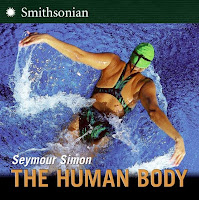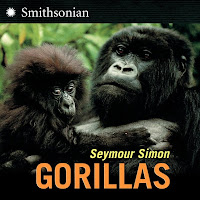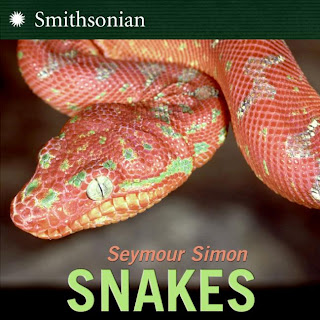February 13, 2009
I was walking down a trail in a swampy area near the shore in a National Wildlife Refuge in Virginia when this poisonous snake, a water moccasin, crawled out of the grasses on one side of the trail and headed across to the other side. Naturally, I had no objections. Why does a water moccasin cross a trail?
To get to the other side, of course. ![]()
A water moccasin is also called a cottonmouth or a black moccasin. It’s called a cottonmouth because it will stand its ground and open its jaws, exposing the white lining of its mouth. Adult water moccasins are large and capable of delivering a painful and potentially fatal bite, but their reputation for attacking people without warning is not exactly accurate.
Water moccasins live in the Eastern part of the United States, usually near slow-moving streams and shallow lakes. They are strong swimmers and will even enter the ocean where they will sometimes swim to nearby islands.
Posted by: Seymour Simon





February 12, 2009

Contest: Unsung Body Parts
Does the world really need another song about "the heart"? Some body parts are celebrated much more than others in songs. Enough already with the "eyes" don’t you think?! Doesn’t your "spleen" or your "kneecap" deserve a musical tribute? Well, now it’s time to help me create a new collection of songs, poems, raps about less famous, but nevertheless important body parts.
Inspired by my new book The Human Body, I’m starting a rather silly contest! Send in a poem, audio clip, video file etc of a short song about an "unsung body part." I’ll post it here, if it tickles my funny bone (hey, there’s an idea for a body part).
The Prize: Winners of the best human body part song get an autographed copy of THE HUMAN BODY.
Posted by: Liz Nealon





February 12, 2009

See Seymour being interviewed about his books and the way he writes.
Posted by: Seymour Simon





February 11, 2009

GORILLAS
Contest: Go Gorilla!
Gorillas and humans share 98% of their DNA. Now is your chance to show how similar our species really are!
First, find an example of gorilla behavior online [see examples below]. Then, submit a short video of you imitating some aspect of gorilla behavior-its walk, its sounds, facial expressions, and more. No costumes are required - in fact, they’re discouraged.
The Prize: An autographed copy of Seymour Simon’s new Gorillas book! Your video also gets posted on the SeymourScience Web site! In case of ties, more than one prize will be given.
Gorilla Behavior Videos
(And just to show you that the street runs both ways - below is a video of a gorilla imitating a human’s walk!)
Posted by: Liz Nealon





February 10, 2009

Seymour,
It was a honor to meet with you and to speak about your new adventures in words and in technology. I have a couple of pictures to share with you. I also have pictures with Liz, if you would like me to pass those on as well. I will begin working this week with Jodi Beyer, my co-worker, to create a question and video from her first grade class. I look forward to the communication! I believe that the blog will be a great way to communicate with your fans, it is a wonderful idea and I wish you well. If you have anything that you would like assistance with that I could provide remotely, I would be willing to assist you. Or, if you have other ideas that you would like from students, I would be happy to assist with that as well. I am the librarian of four schools, so I have a lot of students to pull ideas from!
Thank you again,
Misty Fredrick
School Library Media Specialist
Reedsburg School District, WI
The first photo is of Misty Fredrick, the second, Jodi Beyer
Posted by: Seymour Simon





February 10, 2009


Posted by: Seymour Simon





February 4, 2009
Science News / FOR KIDS: Science Loses Out When Ice Caps Melt
Posted by: Seymour Simon





January 30, 2009
A lion decided one day to remind everyone he was king of the jungle.
He saw a monkey, and roared "Who is the King of the Jungle?"
"You are, Master," said the monkey, cowering.
Then the lion approached a warthog. "Who is the King of the Jungle?" roared the lion.
"You are, my Lord," said the warthog, quivering with fear.
Next the lion met an elephant. "Who is the King of the Jungle?" roared the lion.
The elephant grabbed the lion with his trunk, swung him in the air, slammed him ten times against a tree trunk, threw him into a dense patch of thorns, and strolled away.
"Okay!" shouted the lion. "There’s no need to turn nasty just because you don’t know the answer!"
Posted by: Seymour Simon
January 30, 2009
"Your dog must be sick. He isn’t barking. He just goes tick, tick, tick."
"He’s not sick. He goes tick, tick, tick because he’s a watchdog!"
"Well, if he’s a watchdog, why is he running around in circles?"
"That’s because he’s all wound up!"
Posted by: Seymour Simon
January 30, 2009

Nearly 400 years ago, Italian astronomer Galileo Galilei constructed a tiny astronomical telescope and looked at the night sky. He peered at the planet Jupiter, then a strange and mysterious object. Galileo discovered three faint dots around the planet and wondered what they might be.
Over the following year, Galileo observed Jupiter and these tiny pin-pricks of light. He discovered a fourth and saw that they were in motion around Jupiter. Could they be moons, other worlds in their own right? Galileo had discovered the first satellites circling around a planet other than our own. In future years they were named Io, Europa, Ganymede and Callisto. They are now known as the Galilean Satellites, in honour of the great scientist.
Galileo realized that these four moons were orbiting Jupiter. His observations cast doubt on the accepted view (at that time) that the Earth was the center of the Universe. Years later, the Galilean moons would be used by science to support Copernicus’s theory of a heliocentric, sun-centered universe, which we now know is much closer to the truth.
With a small telescope or a pair of binoculars, you too can see Jupiter and its moons, much as Galileo did nearly 400 years ago. On a crisp and cloudless night, find a safe and dark location to look to the night sky. The best places to look at the sky are away from street lights. The best observing time for Jupiter this year is in the summer. Jupiter is bright during the month of August, making this a good time to view its moons.
Focus your telescope or binoculars on Jupiter and try to pick out the dots of light on either side. These are the moons, just as Galileo saw them! You can even track their positions over consecutive nights, as he did. Even if you don’t observe Jupiter and the Galilean moons during 2009, it’s still worth looking up on a starry night and remembering how, nearly 400 years ago, history was made by Galileo doing the same thing.
Posted by: Seymour Simon




